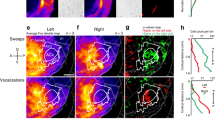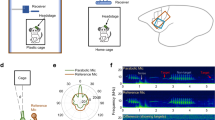Abstract
In humans, sound perceived as speech is processed preferentially by the right ear and the left hemisphere of the brain1–3. Among animals, such an advantage of one hemisphere (lateralization) in processing communication sound from other members of the species has so far been demonstrated only in macaque monkeys4–6. I report here that in the house mouse, which has a very much less elaborate forebrain than man or macaque monkey, the ultrasonic calls that are emitted by young mice to evoke maternal caring behaviour are preferentially recognized by the left hemisphere. In females with no experience of pups, which have been trained to respond to the same ultrasonic calls by conditioning, no advantage for one hemisphere is detected. The results suggest that lateralization of this function evolved early in mammals and emphasize that an innate predisposition for perceiving communication sounds is connected with a left-hemisphere advantage in processing them. This experimental system is a readily-available animal model for studying lateralized auditory brain functions.
This is a preview of subscription content, access via your institution
Access options
Subscribe to this journal
Receive 51 print issues and online access
$199.00 per year
only $3.90 per issue
Buy this article
- Purchase on Springer Link
- Instant access to full article PDF
Prices may be subject to local taxes which are calculated during checkout
Similar content being viewed by others
References
Cutting, J. E. Percept. Psychophys. 16, 601–612 (1974).
Bradshaw, J. L. & Nettleton, N. C. Behav. Brain Sci. 4, 51–91 (1981).
Geschwind, N. & Galaburda, A. M. Archs Neurol. 42, 428–459 (1985).
Petersen, M. R., Beecher, M. D., Zoloth, S. R., Moody, D. B. & Stebbins, W. C. Science 202, 324–327 (1978).
Petersen, M. R. et al. Behav. Neurosci. 98, 779–790 (1984).
Heffner, H. E. & Heffner, R. S. Science 226, 75–76 (1984).
Haack, B., Markl, H. & Ehret, G. in The Auditory Psychobiology of the Mouse (ed. Willott, J. F.) 57–97 (Thomas, Springfield, 1983).
Ehret, G. & Haack, B. J. comp. Physiol. 148, 245–251 (1982).
Ehret, G. & Haack, B. Naturwissenschaften 68, 208 (1981).
Ehret, G. in Categorical Perception (ed. Harnad, S.) (Cambridge University Press, Cambridge, in the press).
Koch, M. thesis, Univ. Konstanz (1986).
Denenberg, V. H. Behav. Brain Sci. 4, 1–49 (1981).
Author information
Authors and Affiliations
Rights and permissions
About this article
Cite this article
Ehret, G. Left hemisphere advantage in the mouse brain for recognizing ultrasonic communication calls. Nature 325, 249–251 (1987). https://doi.org/10.1038/325249a0
Received:
Accepted:
Issue Date:
DOI: https://doi.org/10.1038/325249a0
This article is cited by
-
Lessons from behavioral lateralization in olfaction
Brain Structure and Function (2022)
-
Spinal and Cerebral Integration of Noxious Inputs in Left-handed Individuals
Brain Topography (2021)
-
The impact of fasting on resting state brain networks in mice
Scientific Reports (2019)
-
Circuit asymmetries underlie functional lateralization in the mouse auditory cortex
Nature Communications (2019)
-
Inaudible components of the human infant cry influence haemodynamic responses in the breast region of mothers
The Journal of Physiological Sciences (2019)
Comments
By submitting a comment you agree to abide by our Terms and Community Guidelines. If you find something abusive or that does not comply with our terms or guidelines please flag it as inappropriate.



